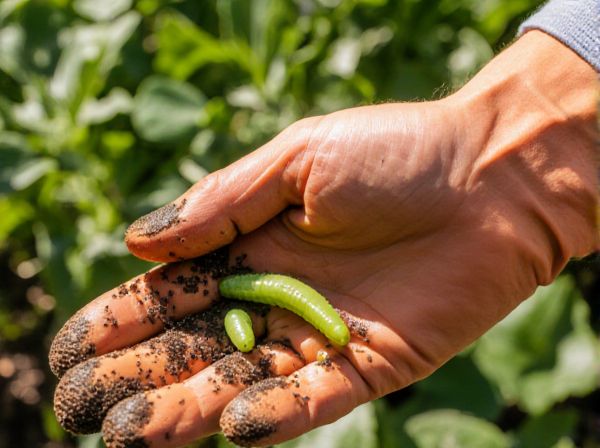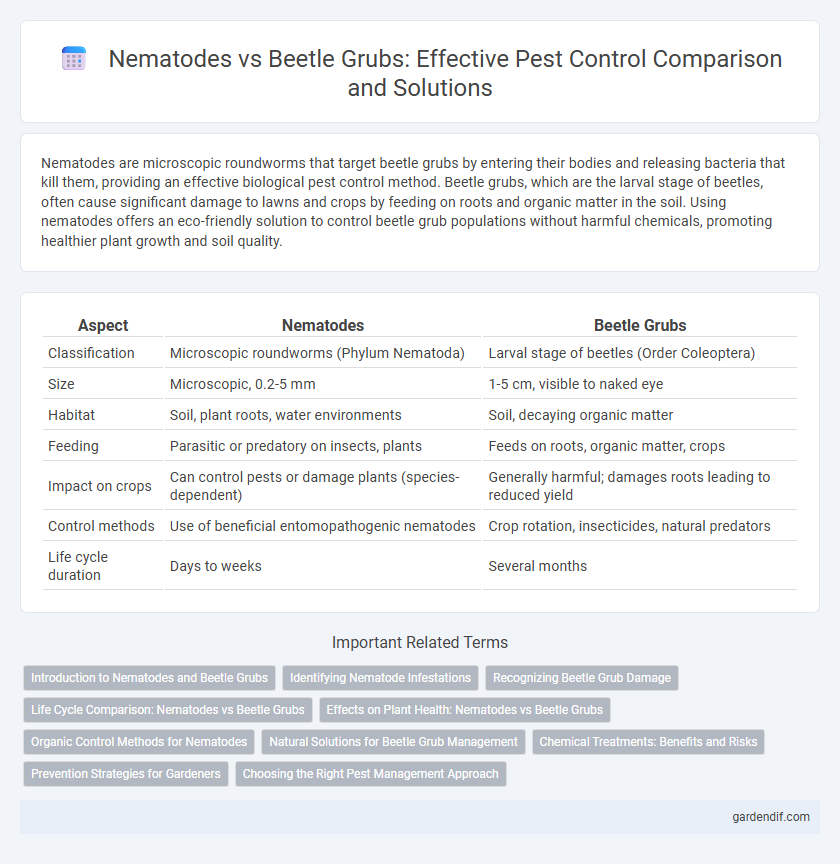
Nematodes vs Beetle Grubs Illustration
Nematodes are microscopic roundworms that target beetle grubs by entering their bodies and releasing bacteria that kill them, providing an effective biological pest control method. Beetle grubs, which are the larval stage of beetles, often cause significant damage to lawns and crops by feeding on roots and organic matter in the soil. Using nematodes offers an eco-friendly solution to control beetle grub populations without harmful chemicals, promoting healthier plant growth and soil quality.
Table of Comparison
| Aspect | Nematodes | Beetle Grubs |
|---|---|---|
| Classification | Microscopic roundworms (Phylum Nematoda) | Larval stage of beetles (Order Coleoptera) |
| Size | Microscopic, 0.2-5 mm | 1-5 cm, visible to naked eye |
| Habitat | Soil, plant roots, water environments | Soil, decaying organic matter |
| Feeding | Parasitic or predatory on insects, plants | Feeds on roots, organic matter, crops |
| Impact on crops | Can control pests or damage plants (species-dependent) | Generally harmful; damages roots leading to reduced yield |
| Control methods | Use of beneficial entomopathogenic nematodes | Crop rotation, insecticides, natural predators |
| Life cycle duration | Days to weeks | Several months |
Introduction to Nematodes and Beetle Grubs
Nematodes are microscopic roundworms that act as natural biological control agents against soil-dwelling pests by infecting and killing beetle grubs. Beetle grubs, the larval stage of beetles, inhabit soil where they feed on plant roots, causing significant damage to lawns, gardens, and crops. Leveraging nematodes for pest management offers an eco-friendly alternative to chemical pesticides by targeting and reducing beetle grub populations effectively.
Identifying Nematode Infestations
Nematode infestations can be identified by symptoms such as root galls, necrosis, and stunted plant growth, which differ from the chewing damage caused by beetle grubs. Unlike beetle grubs that physically consume roots and underground plant parts, nematodes invade root cells, leading to microscopic root lesions and impaired nutrient uptake. Soil sampling and microscopic examination are essential for distinguishing nematode presence from beetle grub damage, facilitating targeted pest management strategies.
Recognizing Beetle Grub Damage
Beetle grub damage is identifiable by irregular tunnels and patches of dead grass or decaying roots beneath the soil surface. Unlike nematodes, which cause subtle root lesions and stunted plant growth, beetle grubs physically consume plant roots, leading to more visible wilting and brown patches in turf or crops. Monitoring soil for beetle grub larvae and observing these distinct symptoms helps differentiate between grub damage and nematode infestations.
Life Cycle Comparison: Nematodes vs Beetle Grubs
Nematodes undergo a simple life cycle involving egg, juvenile, and adult stages, often completing development within a few weeks depending on environmental conditions. Beetle grubs experience a more complex metamorphosis with distinct larval, pupal, and adult beetle stages, typically spanning several months to over a year. Understanding the differences in life cycle duration and development stages between nematodes and beetle grubs is crucial for optimizing pest management strategies.
Effects on Plant Health: Nematodes vs Beetle Grubs
Nematodes, particularly root-knot and lesion nematodes, cause significant damage by penetrating plant roots, leading to galls, root decay, and impaired nutrient uptake, which stunts plant growth and reduces crop yields. Beetle grubs, such as those of scarab beetles, primarily feed on root systems, causing extensive root loss and weakening plants' stability and water absorption capacity. Both pests critically disrupt plant health but nematodes often trigger systemic issues through root tissue invasion, while beetle grubs inflict more mechanical root damage.
Organic Control Methods for Nematodes
Organic control methods for nematodes focus on enhancing soil health through the use of beneficial fungi, such as Paecilomyces lilacinus, and incorporating organic matter like compost and green manure to suppress nematode populations. Crop rotation with resistant plant varieties and cover cropping using marigold or mustard plants disrupts nematode life cycles while promoting biological pest control. Applying biofumigant plant residues and microbial biocontrol agents helps maintain a balanced soil ecosystem that reduces nematode damage without harming beneficial insects like beetle grubs.
Natural Solutions for Beetle Grub Management
Nematodes provide an effective natural solution for beetle grub management by targeting and parasitizing the larvae in the soil, reducing their population without harmful chemicals. Species like Steinernema and Heterorhabditis nematodes penetrate beetle grub bodies, releasing symbiotic bacteria that kill the pest within days. Utilizing nematodes supports sustainable pest control practices, promoting soil health and minimizing environmental impact.
Chemical Treatments: Benefits and Risks
Chemical treatments targeting nematodes offer effective soil pest control by disrupting their life cycle, yet these treatments risk harming beneficial microorganisms and causing environmental contamination. In contrast, chemicals used against beetle grubs, such as neonicotinoids, provide rapid reduction of larvae populations but may lead to resistance development and negatively impact pollinators like bees. Proper application and integrated pest management strategies are essential to maximize benefits while minimizing ecological risks associated with chemical pesticide use.
Prevention Strategies for Gardeners
Nematodes and beetle grubs both pose significant threats to garden health, but effective prevention strategies differ for each pest. Applying beneficial nematodes to soil can naturally control beetle grub populations by parasitizing their larvae, while maintaining healthy soil conditions and using organic mulch deters beetle egg laying. Regularly inspecting plants and incorporating crop rotation minimizes nematode infestations by disrupting their life cycles and reducing habitat suitability.
Choosing the Right Pest Management Approach
Nematodes provide an effective biological pest control method targeting beetle grubs by parasitizing their larvae in soil, reducing reliance on chemical insecticides. Beetle grubs often damage turfgrass and crops, making timely identification crucial for selecting beneficial nematode strains like Steinernema or Heterorhabditis species. Integrating nematode application with cultural practices such as soil aeration and moisture management enhances pest suppression while promoting sustainable pest management strategies.
Nematodes vs Beetle Grubs Infographic

 gardendif.com
gardendif.com